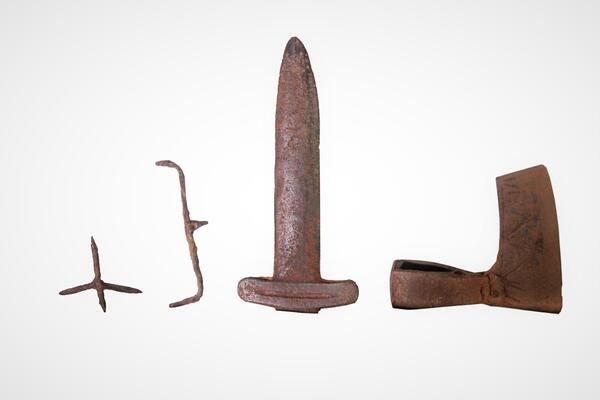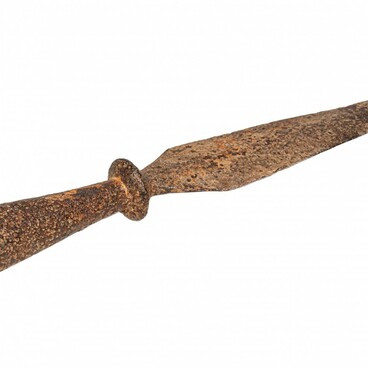One of the museum’s showcases contains items of medieval weaponry from the 14th century, from the time of the Battle of Kulikovo: a dagger, an ax, a caltrop, and an ice-moving spike. The items were found in the 1930-the 1940s in the Kremlin on the territory of the monasteries and elsewhere in the town.
The weapons used in the Middle Ages are mainly cold weapons as well as different siege weapons. In addition, the soldiers often took household items with them on campaigns that could be useful: work axes, knives, and saws to clear a path in a dense forest or to collect firewood.
Axes were common throughout Russia. They varied in size and shape, weight and purpose. Among the battle axes, one of the most famous was a bearded ax with a blade extended downwards. This design allowed the ax to be drawn under the blade so that it would protect the fighter’s hand.
In Russia the anti-cavalry device that consisted of sharp metal spikes pointing in different directions was called ‘chesnok’ (caltrop). It consisted of multidirectional sharp metal spikes.
Usually, there were four spikes, sometimes special hooks were attached to their ends. Horses caught in such hooks at a gallop fell and threw the equestrian out of the saddle.
Ice-moving spikes spread in the harsh climatic conditions of Russia in the 9th-10th centuries. They were attached to the shoe sole or a horseshoe, so as not to slip on ice and snow. Later, spikes were used in peacetime; they existed until the 19th century.
The rarest item of weapons in this collection is a dagger. In Russia they were rare, and the elongated triangular shape and design resembled knightly daggers of the 12th-13th centuries.
Since Kolomna was located on the border and was an important outpost, many weapons are still found in it. First, the city defended Ryazan in the wars with Prince Vladimir, and then it defended Moscow from the Tatar-Mongol horde.
Prince Daniel of Moscow annexed Kolomna to the Moscow Principality after a war with the Ryazan Prince in 1301. The principality received free access to the Oka — the river became an important trade route and one of the waterways to the east.
In the 14th-15th centuries, the city was a place of gathering troops, who set off to the southeast against the Horde. On August 14, 1380, on the bank of the Severka River the Kolomna people united with the Grand Duke Dmitry of Moscow before the Battle of Kulikovo. The review of Russian troops was held on the Deviche Field near the Kolomna before the war with Mamai’s large army.
The weapons used in the Middle Ages are mainly cold weapons as well as different siege weapons. In addition, the soldiers often took household items with them on campaigns that could be useful: work axes, knives, and saws to clear a path in a dense forest or to collect firewood.
Axes were common throughout Russia. They varied in size and shape, weight and purpose. Among the battle axes, one of the most famous was a bearded ax with a blade extended downwards. This design allowed the ax to be drawn under the blade so that it would protect the fighter’s hand.
In Russia the anti-cavalry device that consisted of sharp metal spikes pointing in different directions was called ‘chesnok’ (caltrop). It consisted of multidirectional sharp metal spikes.
Usually, there were four spikes, sometimes special hooks were attached to their ends. Horses caught in such hooks at a gallop fell and threw the equestrian out of the saddle.
Ice-moving spikes spread in the harsh climatic conditions of Russia in the 9th-10th centuries. They were attached to the shoe sole or a horseshoe, so as not to slip on ice and snow. Later, spikes were used in peacetime; they existed until the 19th century.
The rarest item of weapons in this collection is a dagger. In Russia they were rare, and the elongated triangular shape and design resembled knightly daggers of the 12th-13th centuries.
Since Kolomna was located on the border and was an important outpost, many weapons are still found in it. First, the city defended Ryazan in the wars with Prince Vladimir, and then it defended Moscow from the Tatar-Mongol horde.
Prince Daniel of Moscow annexed Kolomna to the Moscow Principality after a war with the Ryazan Prince in 1301. The principality received free access to the Oka — the river became an important trade route and one of the waterways to the east.
In the 14th-15th centuries, the city was a place of gathering troops, who set off to the southeast against the Horde. On August 14, 1380, on the bank of the Severka River the Kolomna people united with the Grand Duke Dmitry of Moscow before the Battle of Kulikovo. The review of Russian troops was held on the Deviche Field near the Kolomna before the war with Mamai’s large army.


